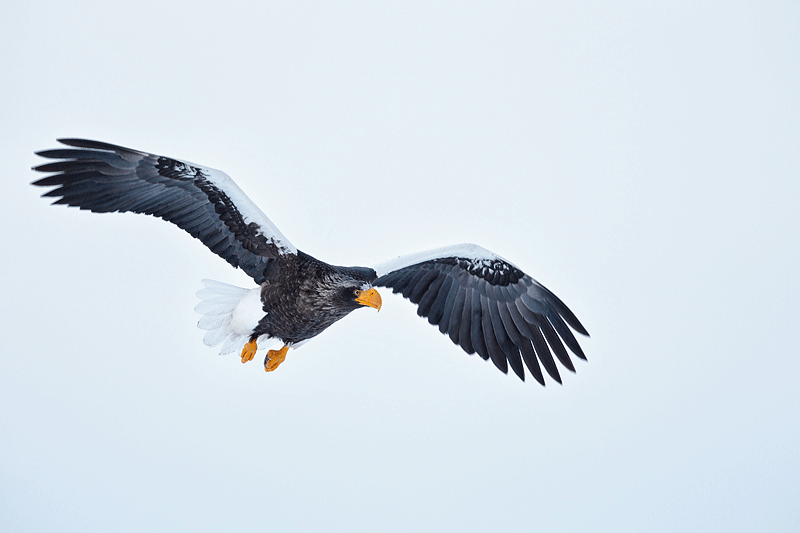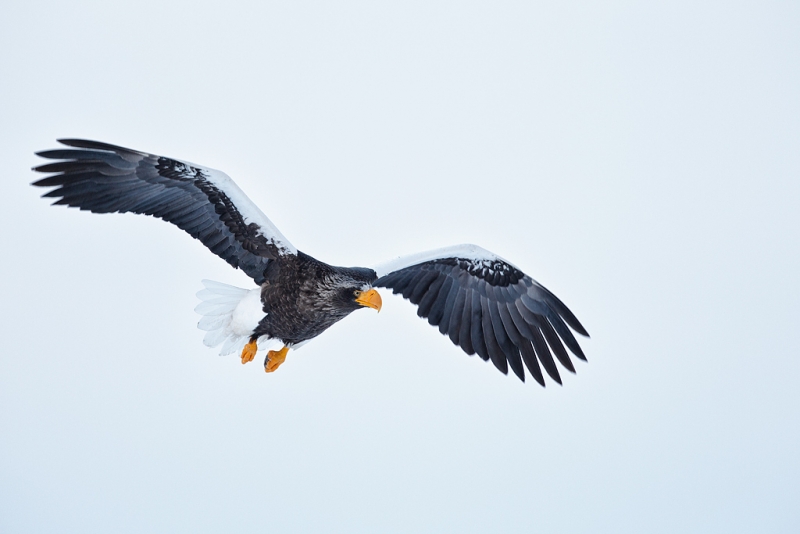|
This image was created with the hand held Canon 300mm f/2.8 L IS II lens, 1.4X III TC, and the Canon EOS-1D Mark IV. ISO 800. Evaluative metering +2 2/3 stops off the grey sky: 1/800 sec. at f/4 in Manual mode. Central Sensor/AI Servo Rear Focus active at the moment of exposure. Click here if you missed the Rear Focus Tutorial. Click on the image to enjoy a larger version. |
Ten Degrees of Flight Photography…
It was -12 degrees Celius, about ten degrees Fahrenheit when we arrived at the dock in the harbor at Rausu, Hokkaido, Japen at 5:30 am in the dark today, Sunday, February 26, 2012. Though the sun broke through at about ten am it got colder as the morning progressed. We were fortunate to start with some clouds as for the most part, it would have been wind against sun. The clouds allowed to photograph the birds flying and landing toward us.
It was pretty much a flying circus with hundreds of gulls and Long-billed Crows along with our target species, White-tailed and the stellar Steller’s Sea Eagles surrounding each of the nearly half dozen tour boats that feed the eagles daily during the long winters. Even with every type of glove and hand warmer known to man kind the cold brutalized the fingers of my right hand. My core was warm, my left hand was toasty, and my feet were even fine, but oh that right hand. Every ten minutes of so I needed to take a warming break so that I could feel those fingers again. Then it was back to the fray.
The scary part is that weather-wise it was a rather benign morning. Most of the rest of the group did better than I did with the cold. I am not sure if my problems are related to my diabetes–control of my blood sugar levels has been excellent for more than two years now–or if I have simply turned into a Florida wimp.

|
Regular readers here know that I have been raving about the manner in which NIK’s Color Efex Pro 4 has completely revamped my workflow. The animated GIF above will give you a good idea of why. Learning when to use Details Extractor (and at what opacity), when to use Tonal Contrast (and at what opacity), and when to use a combination of both requires some practice and experimentation. After converting the RAW file in ACR I figured that Details Extractor would be a no-no with this image but that Tonal Contrast would make it sing. I was correct to the tune of 100%. I ran the Tonal Contrast filter at 100% and did not even bother to see what it looked like with the opacity reduced.
I just peeked out the window of our hotel and see that things bode well for the morning: it is snowing.
Take a Moment
Take a moment to let us know what factors went in to making this a successful image. Note: with a shutter speed of only 1/800 second I am fine with the small amount of blurring of the near wingtip.
NIK
Color Efex Pro 4 is now an integral part of my workflow. Each of the three images above had a 25% White Neutralizer and a 25% Tonal Contrast filter applied immediately after I finished my background clean-up. You can save 15% on all NIK products by clicking here and entering BAA in the Promo Code box at check-out. Then hit Apply to see your savings. You can download a trial copy that will work for 15 days and allow you to create full sized images.
NIK Creative Efex Collection
NIK recently announced the availability of a special limited production bundle of 3 of their most popular products, Color Efex Pro 4, Silver Efex Pro 2, and HDR Efex Pro. You can save more than $200 on the bundle which is available only through NIK affiliates. If you would like additional info, please e-mail with the words “Creative Efex Collection” in the Subject line. If you have been on the fence about purchasing the plug-ins mentioned above this is a great chance to save some significant bucks.
| [Not a valid template] |
B&H Specials
Learn about the Canon Instant Double Rebates on a variety lenses and Speedlites when bundled with one of several Canon dSLR bodies including two of my favorites–the EOS-7D and the EOS-5D MII–and earn free contest entries by clicking here. Offers expire March 3, 2012.
Save up to $350 on Canon lens and camera body bundles (including two of my favorites–the EOS-7D and the EOS-5D MII) and earn free contest entries by clicking here. This offer also expire March 3, 2012.
Support both the Bulletins and the Blog by making all your B & H purchases here.
Remember: you can earn free contest entries with your B & H purchases. Eleven great categories, 34 winning and honored images, and prize pools valued in excess of $20,000. Click here for details.
Shopper’s Guide
Below is a list of the gear used to create the images talked about in this blog post. Thanks a stack to all who have used the Shopper’s Guide links to purchase their gear as a thank you for all the free information that we bring you on the Blog and in the Bulletins. Before you purchase anything be sure to check out the advice in our Shopper’s Guide.
Canon 300mm f/2.8 L IS II lens. The 300 f/2.8 L IS II with the 1.4X III TC is a killer flight combination.
1.4X III TC. The new Series III 1.4X was designed to work best with the new Series II super-telephoto lenses.
Canon EOS-1D Mark IV professional digital camera body. My two Mark IVs are my workhorse digital camera bodies.
And from the BAA On-line Store:
LensCoats. I have a LensCoat on each of my big lenses to protect them from nicks and thus increase their re-sales value. All my big lens LensCoat stuff is in Hardwood Snow pattern.
Double Bubble Level. You will find one in my camera’s hot shoe whenever I am not using flash.
Black Rapid RS-7 Strap. The Black Rapid RS-& strap allows me easy access to the lens on my shoulder while working behind my big lens on a tripod. And for flight photography from a boat or a zodiac it gives me security knowing that my rig will not wind up in the drink.
The Lens Align Mark II. I use the Lens Align Mark II pretty much religiously to micro-adjust all of my gear an average of once a month and always before a major trip. Enjoy our free comprehensive tutorial here.
Canon EOS-1D Mark IV User’s Guide. Learn to set up your Mark IV for flight photography the way that I do. User’s Guides are also available for the 7D and the Mark III here.
BreezeBrowser. I do not see how any digital photographer can exist without this program.
















Thanks all who chimed in. You did a good job of listing the factors that made this a successful image. The one big miss was the light provided by the sea ice acting as a huge reflector. Snow does the same thing.
Love all the images posted from your trip so far. The Eagle is lovely, nice flight pose. I like the separation between the bill and the bird’s left wing and the separation of the bird’s right wing and the tail feathers. Nice clean-up as well. Your right hand is the one that became infected after the trigger finger procedure wasn’t it…perhaps something to do with that? Minus 12 Celsius…sounds like Ontario weather 🙂
Good job with the plusses. It was my left that had the surgery. The right hand comes out of the fold-back mitten for shooting and is more exposed than the left :).
Even the eagle looks cold; look at its feet, balled into fists! Great shot.
David
Thank you sir. I think that they do that even when it is warm….
You’ll be glad to know we had some -20c days (-24c one morning!) further south at the swans and cranes two weeks ago. The fingers on both my hands suffered a fair bit even with my retractable mittens stuffed full of hand warmers. But you know what? the suffering was worth while as the photographic opportunities were incredible. See you soon. Paul
We head south to the swans in two days. Hope that the place is not totally frozen over…. See you in a bit.
Yes, Diabetes can cause a decrease in blood flow to the hands and feet, so be careful. You do not want to get a case of frost bite! Not sure if you are using a glove liner inside your gloves or mittens, but the extra layer from the glove liners may help alot. Hopefully you can find a pair at a store over there. If not, you can put a hand warmer on the front of your hand and a second one on the back of your hand. Just be careful not to burn your skin with the hand warmers (yeah, another problem diabetics are prone to). Good luck with the rest of your trip.
Was using glove liners and several pairs of big gloves including Black Diamonds and hand warmers as described. Trigger finger and right thumb still get very cold. I am too much of a pansy to get frost bite–when it starts hurting just a bit I take a cabin break. They are the warmest but it is very difficult to operate the camera with them on.
Artie, we found these gloves invaluable even in Antarctica: http://www.aquatech.net/sensory-gloves.php.
Waterproof breathable outer shell
Double fast drying breathable insulation layers
Instant exposure of Thumb and Index for fine control
Silicon Palm for superior grip
Stay warm 🙂
Cheers, Jay
Thanks for the link Jay. I have tried them all and none of them work. But I shall try a pair for Bosque next year and let you know how they work. What can I say, I just have cold hands. And it will be getting colder soon as we head for the swans and the cranes. 🙂
DEAR ART: MUCH AS WE WANTED TO GO TO JAPAN, I’M GLAD WE DIDN’T. STOKES AND I COULD NOT HAVE STOOD THE COLD. WHEN MY HANDS GET COLD, MY ARTHRITIS KICKS IN AND I CAN’T EVEN OPERATE MY CAMERA.
PAT FISHBURNE
Good thinking 🙂 Love to you both.
Your cold hand probably stems from decreased circulation, partly as a result of your hand surgery, and partly because of your diabetes. Diabetes is known for its effects on peripheral circulation. In the future, I suggest you purchase some small chemical handwarmers ..little packages that you activate and “wear” inside your gloves. The ones I purchase are called HEAT Factory and they last for 8 hours. As for Nik Color Efex Pro, like you I am using it and find it eliminates a lot of fussing around in Photoshop. I look forward to your coverage in Digital Basics. Experimentation is key. Enjoy those magnificent eagles.
Thanks on all counts Glen. I was using hand warmers yesterday. Today was a bit warmer :). We had a killer morning–I, a very conservative shooter created more than 1,500 images. Time to start editing.
What a handsome bird! Apparently these are pretty much the largest Eagle of all, and they consider a Japanese winter to be a nice holiday from the Russian one, though some stay there anyway! The angle and wing position are really strong factors in this image, plus the super yellow of the beak and feet stand out despite the brightness of the sky. I’m with you on not minding a blur of feathers, nothing in flight is motionless. And although a faster shutter speed may capture a beautiful split moment of natural history even with a hummingbird, the realism of a bit of blurring is more easier on the eye. Just my opinion of course. ;¬)
Did I just type “more easier” ?
Yes you did. And unless you were referring to a bird that was humming hummingbird is one word not two 🙂
Good job with the positive factors.
Heh, maybe I shouldn’t type stuff early in the morning. 😉